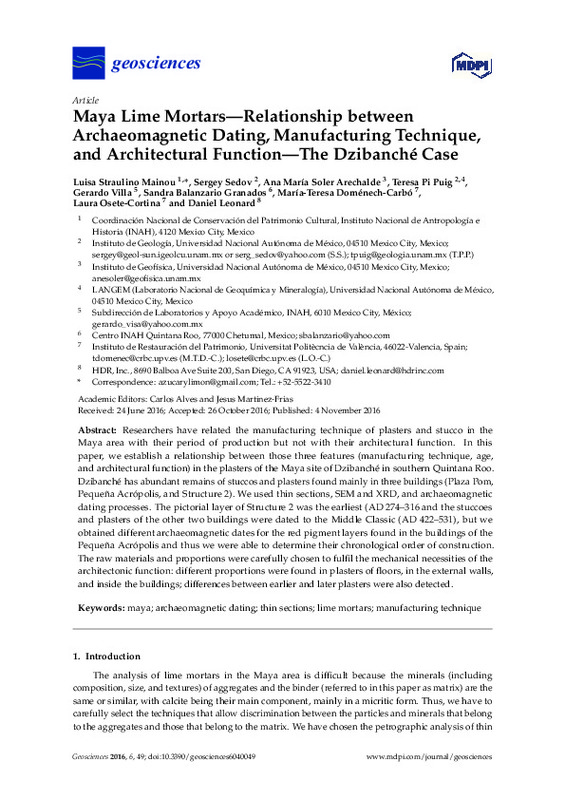JavaScript is disabled for your browser. Some features of this site may not work without it.
Buscar en RiuNet
Listar
Mi cuenta
Estadísticas
Ayuda RiuNet
Admin. UPV
Maya lime mortars. Relationships between archaeometric dating, manufacturing technique and architectural function. The Dzibanché case
Mostrar el registro sencillo del ítem
Ficheros en el ítem
| dc.contributor.author | Straulino Mainou, Luisa
|
es_ES |
| dc.contributor.author | Sedov, Sergey
|
es_ES |
| dc.contributor.author | Soler Arechalde, Ana María
|
es_ES |
| dc.contributor.author | Pi Puig, Teresa
|
es_ES |
| dc.contributor.author | Villa, Gerardo
|
es_ES |
| dc.contributor.author | Balanzario Granados, Sandra
|
es_ES |
| dc.contributor.author | Domenech Carbo, Mª Teresa
|
es_ES |
| dc.contributor.author | Osete Cortina, Laura
|
es_ES |
| dc.contributor.author | Leonard, Daniel
|
es_ES |
| dc.coverage.spatial | east=-88.7596607208252; north=18.639372999528145; name=Othón P. Blanco, Quintana Roo, Mèxic | |
| dc.date.accessioned | 2018-03-30T04:12:44Z | |
| dc.date.available | 2018-03-30T04:12:44Z | |
| dc.date.issued | 2016 | es_ES |
| dc.identifier.issn | 1226-4806 | es_ES |
| dc.identifier.uri | http://hdl.handle.net/10251/99948 | |
| dc.description.abstract | [EN] Researchers have related the manufacturing technique of plasters and stucco in the Maya area with their period of production but not with their architectural function. In this paper, we establish a relationship between those three features (manufacturing technique, age, and architectural function) in the plasters of the Maya site of Dzibanche in southern Quintana Roo. Dzibanche has abundant remains of stuccos and plasters found mainly in three buildings (Plaza Pom, Pequena Acropolis, and Structure 2). We used thin sections, SEM and XRD, and archaeomagnetic dating processes. The pictorial layer of Structure 2 was the earliest (AD 274-316 and the stuccoes and plasters of the other two buildings were dated to the Middle Classic (AD 422-531), but we obtained different archaeomagnetic dates for the red pigment layers found in the buildings of the Pequena Acropolis and thus we were able to determine their chronological order of construction. The raw materials and proportions were carefully chosen to fulfil the mechanical necessities of the architectonic function: different proportions were found in plasters of floors, in the external walls, and inside the buildings; differences between earlier and later plasters were also detected. | es_ES |
| dc.description.sponsorship | We acknowledge the archeological project of Dzibanche and Centro INAH Quintana Roo who generously allowed the extraction of the samples for this study; also we acknowledge the Universidad Nacional Autonoma de Mexico that gave a grant that allowed a three month research in the laboratories of the Universitat Politecnica de Valencia. Financial support for the analysis of organic materials is kindly acknowledged; it was provided by the Spanish MINECO R+D project CTQ2014-53736-C3-1-P and also supported with ERDEF funds. The authors thank Jaime Diaz for his assistance in preparing thin sections. | |
| dc.language | Inglés | es_ES |
| dc.publisher | Springer-Verlag | es_ES |
| dc.relation.ispartof | Geosciences Journal | es_ES |
| dc.rights | Reconocimiento (by) | es_ES |
| dc.subject | Maya | es_ES |
| dc.subject | Archaeomagnetic dating | es_ES |
| dc.subject | Thin sections | es_ES |
| dc.subject | Lime mortars | es_ES |
| dc.subject | Manufacturing technique | es_ES |
| dc.subject.classification | PINTURA | es_ES |
| dc.title | Maya lime mortars. Relationships between archaeometric dating, manufacturing technique and architectural function. The Dzibanché case | es_ES |
| dc.type | Artículo | es_ES |
| dc.identifier.doi | 10.3390/geosciences6040049 | es_ES |
| dc.relation.projectID | info:eu-repo/grantAgreement/MINECO//CTQ2014-53736-C3-1-P/ES/APLICACION DE LAS TECNICAS NANOELECTROQUIMICAS Y BIOTECNOLOGIAS EN EL ESTUDIO Y CONSERVACION DEL PATRIMONIO EN METAL/ | es_ES |
| dc.rights.accessRights | Abierto | es_ES |
| dc.contributor.affiliation | Universitat Politècnica de València. Instituto Universitario de Restauración del Patrimonio - Institut Universitari de Restauració del Patrimoni | es_ES |
| dc.contributor.affiliation | Universitat Politècnica de València. Departamento de Conservación y Restauración de Bienes Culturales - Departament de Conservació i Restauració de Béns Culturals | es_ES |
| dc.description.bibliographicCitation | Straulino Mainou, L.; Sedov, S.; Soler Arechalde, AM.; Pi Puig, T.; Villa, G.; Balanzario Granados, S.; Domenech Carbo, MT.... (2016). Maya lime mortars. Relationships between archaeometric dating, manufacturing technique and architectural function. The Dzibanché case. Geosciences Journal. 6(4):49-1-49-27. https://doi.org/10.3390/geosciences6040049 | es_ES |
| dc.description.accrualMethod | S | es_ES |
| dc.relation.publisherversion | http://doi.org/10.3390/geosciences6040049 | es_ES |
| dc.description.upvformatpinicio | 49-1 | es_ES |
| dc.description.upvformatpfin | 49-27 | es_ES |
| dc.type.version | info:eu-repo/semantics/publishedVersion | es_ES |
| dc.description.volume | 6 | es_ES |
| dc.description.issue | 4 | es_ES |
| dc.relation.pasarela | S\326840 | es_ES |
| dc.contributor.funder | Ministerio de Economía, Industria y Competitividad | es_ES |








